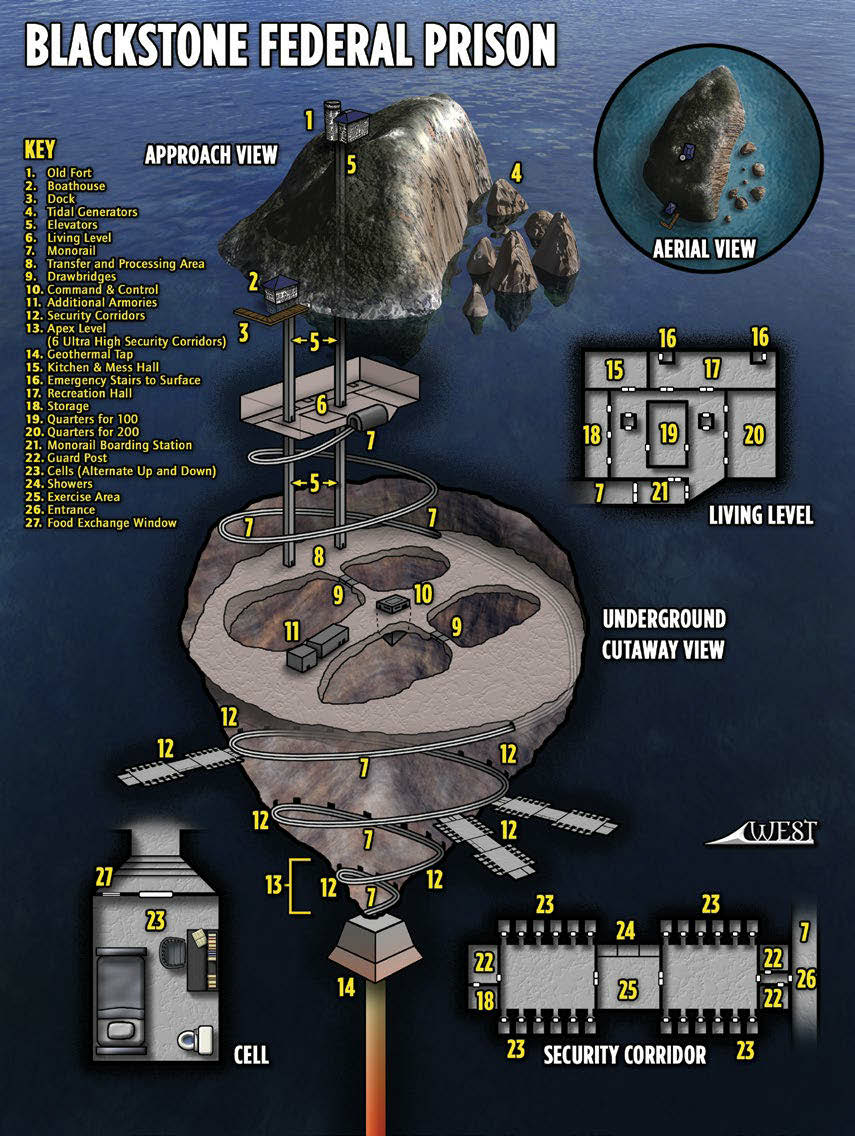Blackstone Federal Penitentiary
In 1964, the federal government commissioned a prison capable of holding super-powered inmates in response to the growing number of super-criminals. Blackstone Penitentiary was the first of its kind, and remains in operation today.
Formed of dark granite jutting out of the sea, “Blackstone” aptly describes the small, isolated island about a mile and a half beyond Freedom City’s Great Bay. It was a military weapons depot and brig affiliated with Lonely Point during the Second World War, decommissioned by the federal government, and later refitted as a super-prison.
Operational as of 1964, Blackstone has become the defacto prison for many American super-criminals. Blackstone saw many escapes in its early years, but fewer after Warden Jerry Kramer accepted Daedalus’ assistance in redesigning the cell blocks in 1966. The Blackstone Riots of 1983 saw the warden and 40 guards killed by inmates trying to escape; only the cool-headedness of a few guards—including then-rookie Joshua Drummer—and the technology of Dr. Abby Wallace kept all the prisoners on the island. The only prisoner casualties of the riot were its instigators, Doc Abattoir and Countess Azure, and the villains Ramrod, Sir Razor, the Wrath, the Silver Satyr, Ms. Malice, and the pyrotechnic triplets ConflagNation—all killed either by other inmates or by not retreating from energy barriers erected against their escape.
Omega struck Blackstone during the Terminus Invasion, his Omegadrones blasting away the western wall of the complex and unleashing many of the prisoners to sow chaos or become agents of the Lord of the Terminus; after that, the surface structures of the prison were moved almost entirely underground.
The construction of Lockdown and the newer Deep Six facility means Blackstone is no longer the only U.S. super-prison, although it remains the oldest and the one with the largest number of inmates.
Architecture
At first glance, the complex has only two visible buildings: the arrival dock and boathouse, and the low structure atop the lonely rock hill used as a secondary watch post. Below ground, and accessible from either building, is where Blackstone truly begins: a series of corridors and chambers cut from solid rock. Tunnels connect all sites, and a monorail provides personnel with fast transport to all areas of the penitentiary and around the central core.
Blackstone has a Command and Control (C&C) room at the heart of the complex, where administrators and senior guards monitor all activities within the prison. There are barracks and personal apartments for staff in the uppermost parts of the complex (within 80 feet of the surface), reachable by stairwells if the prison is not on alert. Fresh air cycles into the prison constantly, and supplies come in by ferry twice a week. A geothermal tap supplies energy for cell integrity, life support, and defenses, with tidal power from the currents around the island covering all other energy needs. Life support, air, and some foodstuffs come from hydroponics bays in the central core.
Prisoners reside no closer than 150 feet from the surface, with the most dangerous kept in the deepest levels of the complex. All cells are off corridors radiating out from the central core, with guard posts at each end of the corridor. At the center of each corridor is a common room where prisoners congregate for up to four hours a day. Unless they have visitors or are paroled, most prisoners do not leave their security corridor.
There are 24 cells along each 200-foot corridor, 12 on each side; between 15 and 20 of these 30 corridors are operational and occupied at any time. For the most dangerous inmates, security reduces the number of cells in a corridor to eight, with 20 guards. All prisoners have cells customized specifically for them, and energy fields permeate the rock walls of the cells preventing anyone from digging their way out. Artificial diamondmatrix panels (Toughness 18) seal the front of the cells, allowing full visual contact with prisoners at all times; they do have some limited privacy by staggering cells entrances across the corridor. The panels can turn translucent or opaque by command from the cell control pads.
Found in the common rooms and nearly everywhere else in the complex are the main defenses of the prison, supplementing any individual defenses placed on any inmate’s cell, and controlled from the guard posts, C&C, and by senior Blackstone personnel with special control pads. These defenses include:
- Powerful strobe lights aimed into each individual cell.
- Anesthetic gas released into the security corridors or cells.
- An electrical field along cell seals, security corridor floors, cell walls, and cell floors.
- Seismic sensors pick up any digging in the surrounding rock and triggering force fields around the intrusion areas.
History
BLACKSTONE SECURITY (THE “BLACKGUARDS”)
There are hundreds of security officers at Blackstone who rotate on six different 4-hour shifts. Guards remain on the island unless on furlough—two days out of every ten—living in on-site barracks the rest of the time.
Blackguards train and work in pairs and quartets, preventing prisoners from overwhelming a single guard. Basic Blackguard tactics focus on keeping prisoners contained first and subdued second, so problems with more than one inmate often have guards using force fields to limit their movement before they move in to secure the prisoner.
Guard duty at Blackstone is dangerous, and the security officers all know it. They are trained and paid accordingly and have to pass rigorous screening and testing in order to work at the prison. The Blackguards take their professional reputation quite seriously, and any blemish on their honor as a unit affects them all. Nevertheless, there have been instances of guards who have been compromised, either by outside influences or old-fashioned extortion.
Blackguards have access to MAX and Super-MAX armor, and usually have six MAX units on-duty at any given time; Super-MAX units are only broken out in times of emergency. In keeping with their nickname, Blackguard power-armor units are painted in grey-black urban camouflage schemes.
Type
Prison
Characters in Location
Remove these ads. Join the Worldbuilders Guild










Comments